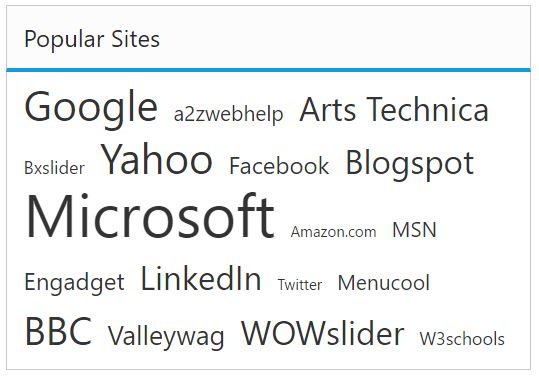Getting Started
30 Nov 201612 minutes to read
This section explains briefly about how to create a TagCloud in your application with JavaScript. The TagCloud can be easily configured to the div element in which the tags are placed. The following screenshot illustrates the functionality of a TagCloud widget with a list of the topmost search engines.

Create TagCloud widget in React JS
You can create a React application and add necessary scripts and styles with the help of the given React Getting Started Documentation.
Create a JSX file for rendering TagCloud component using <EJ.TabCloud> syntax. Add required properties to it in <EJ.TagCloud> tag element
"use strict";
var websiteCollection = [
{ text: "Google", url: "http://www.google.co.in", frequency: 20 },
{ text: "a2zwebhelp", url: "http://www.a2zwebhelp.com", frequency: 3 },
{ text: "Arts Technica", url: "http://arstechnica.com/", frequency: 8 },
{ text: "Bxslider", url: "http://bxslider.com/examples", frequency: 2 },
{ text: "Yahoo", url: "http://in.yahoo.com/", frequency: 12 },
{ text: "Facebook", url: "https://www.facebook.com/", frequency: 5 },
{ text: "Blogspot", url: "http://www.blogspot.com/", frequency: 8 },
{ text: "Microsoft", url: "http://www.microsoft.com/", frequency: 20 },
{ text: "Amazon.com", url: "http://www.amazon.com/", frequency: 1 },
{ text: "MSN", url: "http://www.msn.com/", frequency: 3 },
{ text: "Engadget", url: "http://www.engadget.com/", frequency: 5 },
{ text: "LinkedIn", url: "http://www.linkedIn.com/", frequency: 9 },
{ text: "Twitter", url: "http://www.Twitter.com/", frequency: 0 },
{ text: "Menucool", url: "http://www.menucool.com", frequency: 3 },
{ text: "BBC", url: "http://www.bbc.co.uk/", frequency: 11 },
{ text: "Valleywag", url: "http://valleywag.gawker.com/", frequency: 6 },
{ text: "WOWslider", url: "http://wowslider.com", frequency: 9 },
{ text: "W3schools", url: "http://www.w3schools.com/", frequency: 2 }
];
ReactDOM.render(
<EJ.TagCloud width="100%" cssClass="alignc" titleText= "Tech Sites" dataSource={websiteCollection}>
</EJ.TagCloud>,
document.getElementById('tagcloud-default')
);Define an HTML element for adding TabCloud in the application and refer the JSX file.
<div id="tagcloud-default"></div>
<script src="app/tagcloud/default.js">The following screenshot displays the output of the above code example.

Set Min and Max Font Size
In the above code example, the frequency properties are used to set the min and max font size to the TagCloud list item.
var websiteCollection = [
{ text: "Google", url: "http://www.google.co.in", frequency: 20 },
{ text: "a2zwebhelp", url: "http://www.a2zwebhelp.com", frequency: 3 },
{ text: "Arts Technica", url: "http://arstechnica.com/", frequency: 8 },
{ text: "Bxslider", url: "http://bxslider.com/examples", frequency: 2 },
{ text: "Yahoo", url: "http://in.yahoo.com/", frequency: 12 },
{ text: "Facebook", url: "https://www.facebook.com/", frequency: 5 },
{ text: "Blogspot", url: "http://www.blogspot.com/", frequency: 8 },
{ text: "Microsoft", url: "http://www.microsoft.com/", frequency: 20 },
{ text: "Amazon.com", url: "http://www.amazon.com/", frequency: 1 },
{ text: "MSN", url: "http://www.msn.com/", frequency: 3 },
{ text: "Engadget", url: "http://www.engadget.com/", frequency: 5 },
{ text: "LinkedIn", url: "http://www.linkedIn.com/", frequency: 9 },
{ text: "Twitter", url: "http://www.Twitter.com/", frequency: 0 },
{ text: "Menucool", url: "http://www.menucool.com", frequency: 3 },
{ text: "BBC", url: "http://www.bbc.co.uk/", frequency: 11 },
{ text: "Valleywag", url: "http://valleywag.gawker.com/", frequency: 6 },
{ text: "WOWslider", url: "http://wowslider.com", frequency: 9 },
{ text: "W3schools", url: "http://www.w3schools.com/", frequency: 2 }
];
ReactDOM.render(
<EJ.TagCloud width="100%" cssClass="alignc" titleText= "Tech Sites" dataSource={websiteCollection}>
</EJ.TagCloud>,
document.getElementById('tagcloud-default')
);In the above code, the min font size is 0 and max font size is 20.
Set event to perform an operation
Here, you can set the TagCloud events such as create, mouseover, mouseout, click.
<div id="tagcloud-default"></div>
<script src="app/tagcloud/default.js">var websiteCollection = [
{ text: "Google", url: "http://www.google.co.in", frequency: 12 },
{ text: "a2zwebhelp", url: "http://www.a2zwebhelp.com", frequency: 3 },
{ text: "Arts Technica", url: "http://arstechnica.com/", frequency: 8 },
{ text: "Bxslider", url: "http://bxslider.com/examples", frequency: 2 },
{ text: "Yahoo", url: "http://in.yahoo.com/", frequency: 12 },
{ text: "Facebook", url: "https://www.facebook.com/", frequency: 5 },
{ text: "Blogspot", url: "http://www.blogspot.com/", frequency: 8 },
{ text: "Microsoft", url: "http://www.microsoft.com/", frequency: 20 },
{ text: "Amazon.com", url: "http://www.amazon.com/", frequency: 1 },
{ text: "MSN", url: "http://www.msn.com/", frequency: 3 },
{ text: "Engadget", url: "http://www.engadget.com/", frequency: 5 },
{ text: "LinkedIn", url: "http://www.linkedIn.com/", frequency: 9 },
{ text: "Twitter", url: "http://www.Twitter.com/", frequency: 0 },
{ text: "Menucool", url: "http://www.menucool.com", frequency: 3 },
{ text: "BBC", url: "http://www.bbc.co.uk/", frequency: 11 },
{ text: "Valleywag", url: "http://valleywag.gawker.com/", frequency: 6 },
{ text: "WOWslider", url: "http://wowslider.com", frequency: 9 },
{ text: "W3schools", url: "http://www.w3schools.com/", frequency: 2 }
];
var DefaultTagcloud = React.createClass({
componentDidMount: function () {
$scope.oncreate=function(){
alert();
}
$scope.onmouseover=function(){
alert();
}
$scope.onmouseout=function(){
alert();
}
$scope.onclick=function(){
alert();
}
},
render: function () {
return (
<EJ.TagCloud width="100%" cssClass="alignc" titleText= "Tech Sites" dataSource={websiteCollection} create={oncreate} mouseOver={onmouseover} mouseOut={onmouseout} click={onclick}>
</EJ.TagCloud>,
);
}
});
ReactDOM.render(<DefaultTagcloud />, document.getElementById('tagcloud-default'));In the above code example, the alert() function is used to show the events that happened.